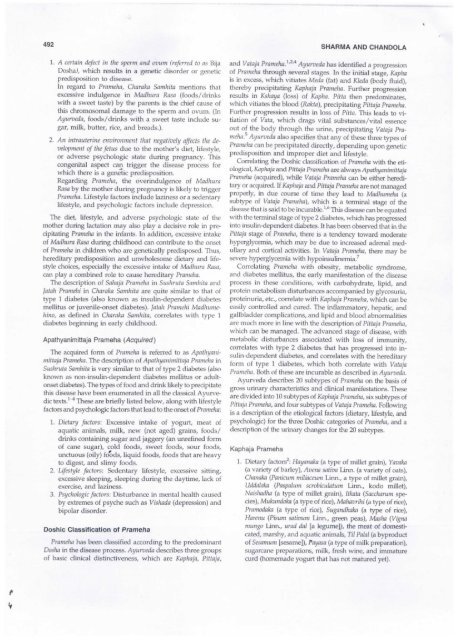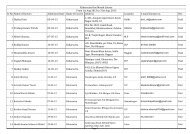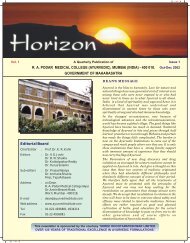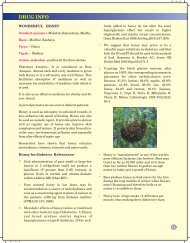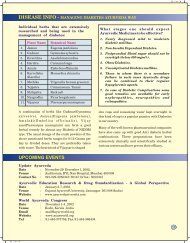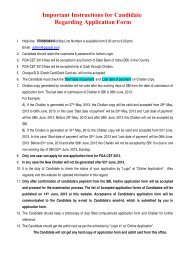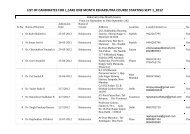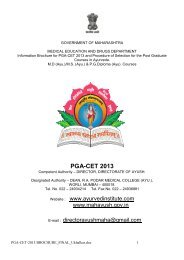Prameha in terms of Diabetes Mellitus, Metabolic syndrome and ...
Prameha in terms of Diabetes Mellitus, Metabolic syndrome and ...
Prameha in terms of Diabetes Mellitus, Metabolic syndrome and ...
- No tags were found...
Create successful ePaper yourself
Turn your PDF publications into a flip-book with our unique Google optimized e-Paper software.
492 SHARMA AND CHANDOLA1. A certa<strong>in</strong> defect <strong>in</strong> the sperm <strong>and</strong> ovum (referred to as BijaDoshaJ, which results <strong>in</strong> a genetic disorder or geneticpredisposition to disease.In regard to <strong>Prameha</strong>, Charaka Samhita mentions thatexcessive <strong>in</strong>dulgence <strong>in</strong> Madhura Rasa (foods/dr<strong>in</strong>kswith a sweet taste) by the parents is the chief cause <strong>of</strong>this chromosomal damage to the sperm <strong>and</strong> ovum. (InAyurveda, foods/dr<strong>in</strong>ks with a sweet taste <strong>in</strong>clude sugar, milk, butter, rice, <strong>and</strong> breads.).2. An <strong>in</strong>trauter<strong>in</strong>e environment that negatively affects the development <strong>of</strong> the fetus due to the mother's diet, lifestyle,or adverse psychologic state dur<strong>in</strong>g pregnancy. Thiscongenital aspect can trigger the disease process forwhich there is a genetic predisposition.Regard<strong>in</strong>g <strong>Prameha</strong>, the over<strong>in</strong>dulgence <strong>of</strong> MadhuraRasa by the mother dur<strong>in</strong>g pregnancy is likely to trigger<strong>Prameha</strong>. Lifestyle factors <strong>in</strong>clude laz<strong>in</strong>ess or a sedentarylifestyle, <strong>and</strong> psychologic factors <strong>in</strong>clude depression.The diet, lifestyle, <strong>and</strong> adverse psychologic state <strong>of</strong> themother dur<strong>in</strong>g lactation may also play a decisive role <strong>in</strong> precipitat<strong>in</strong>g Pramchn <strong>in</strong> the <strong>in</strong>fants. In addition, excessive <strong>in</strong>take<strong>of</strong> Madhura Rasa dur<strong>in</strong>g childhood can contribute to the onset<strong>of</strong> Pramelm <strong>in</strong> children who are genetically predisposed. Thus,hereditary predisposition <strong>and</strong> unwholesome dietary <strong>and</strong> lifestyle choices, especially the excessive <strong>in</strong>take <strong>of</strong> Mndhiira Rasa,can play a comb<strong>in</strong>ed role to cause hereditary <strong>Prameha</strong>.The description <strong>of</strong> Sahaja <strong>Prameha</strong> <strong>in</strong> Sushruta Samhita <strong>and</strong>Jatah Pramehi <strong>in</strong> Charaka Samhita are quite similar to that <strong>of</strong>type 1 diabetes (also known as <strong>in</strong>sul<strong>in</strong>-dependent diabetesmellirus or juvenile-onset diabetes). Jatah Pramehi Madlmrneh<strong>in</strong>o,as def<strong>in</strong>ed <strong>in</strong> Charaka Samhita, correlates with type 1diabetes beg<strong>in</strong>n<strong>in</strong>g <strong>in</strong> early childhood.Apathyanimittaja <strong>Prameha</strong> (Acquired)The acquired form <strong>of</strong> <strong>Prameha</strong> is referred to as Apathyanimittaja <strong>Prameha</strong>. The description <strong>of</strong> Apathyanimittaja <strong>Prameha</strong> <strong>in</strong>Sitshruta Samhita is very similar to that <strong>of</strong> type 2 diabetes (alsoknown as non-<strong>in</strong>sul<strong>in</strong>-dependent diabetes mellitus or adultonsetdiabetes). The types <strong>of</strong> food <strong>and</strong> dr<strong>in</strong>k likely to precipitatethis disease have been enumerated <strong>in</strong> all the classical Ayurvedictexts.1"4 These are briefly listed below, along with lifestylefactors <strong>and</strong> psychologic factors that lead to the onset <strong>of</strong> <strong>Prameha</strong>:<strong>and</strong> Vataja <strong>Prameha</strong>?'2-4 Ayurveda has identified a progression<strong>of</strong> <strong>Prameha</strong> through several stages. In the <strong>in</strong>itial stage, Kaphais <strong>in</strong> excess, which vitiates Meda (fat) <strong>and</strong> Kleda (body fluid),thereby precipitat<strong>in</strong>g Kaphaja <strong>Prameha</strong>. Further progressionresults <strong>in</strong> Kshaya (loss) <strong>of</strong> Kapha. Pitta then predom<strong>in</strong>ates,which vitiates the blood (Rakta), precipitat<strong>in</strong>g Pittaja <strong>Prameha</strong>.Further progression results <strong>in</strong> loss <strong>of</strong> Pitta. This leads to vitiation <strong>of</strong> Vata, which drags vital substances/vital essenceout <strong>of</strong> the body through the ur<strong>in</strong>e, precipitat<strong>in</strong>g Vataja <strong>Prameha</strong>.' Ayurveda also specifies that any <strong>of</strong> these three types <strong>of</strong><strong>Prameha</strong> can be precipitated directly, depend<strong>in</strong>g upon geneticpredisposition <strong>and</strong> improper diet <strong>and</strong> lifestyle.Correlat<strong>in</strong>g the Dosliic classification <strong>of</strong> <strong>Prameha</strong> with the etiological,Kaphaja <strong>and</strong> Pittaja <strong>Prameha</strong> are always Apathyanimittaja<strong>Prameha</strong> (acquired), while Vataja <strong>Prameha</strong> can be either hereditary or acquired. If Kaplwja <strong>and</strong> Pittaja Pramehn are not managedproperly, <strong>in</strong> due course <strong>of</strong> time they lead to Madhwnelia (asubtype <strong>of</strong> Vataja <strong>Prameha</strong>), which is a term<strong>in</strong>al stage <strong>of</strong> thedisease mat is said to be <strong>in</strong>curable.1'6 This disease can be equatedwith the term<strong>in</strong>al stage <strong>of</strong> type 2 diabetes, which has progressed<strong>in</strong>to <strong>in</strong>sul<strong>in</strong>-dependent diabetes. It has been observed that <strong>in</strong> thePittaja stage <strong>of</strong> <strong>Prameha</strong>, mere is a tendency toward moderatehyperglycemia, which may be due to <strong>in</strong>creased adrenal medullary <strong>and</strong> cortical activities. In Vaiaja <strong>Prameha</strong>, there may besevere hyperglycemia with hypo<strong>in</strong>sul<strong>in</strong>emia.7Correlat<strong>in</strong>g <strong>Prameha</strong> with obesity, metabolic <strong>syndrome</strong>,<strong>and</strong> diabetes mellitus, the early manifestation <strong>of</strong> the diseaseprocess <strong>in</strong> these conditions, with carbohydrate/ lipid, <strong>and</strong>prote<strong>in</strong> metabolism disturbances accompanied by glycosuria,prote<strong>in</strong>uria, etc., correlate with Kaphaja <strong>Prameha</strong>, which can beeasily controlled <strong>and</strong> cured. The <strong>in</strong>flarmnatory, hepatic, <strong>and</strong>gallbladder complications, <strong>and</strong> lipid <strong>and</strong> blood abnormalitiesare much more <strong>in</strong> l<strong>in</strong>e with the description <strong>of</strong> Pittaja Pramehn,which can be managed. The advanced stage <strong>of</strong> disease, withmetabolic disturbances associated with loss <strong>of</strong> immunity,correlates with type 2 diabetes that has progressed <strong>in</strong>to <strong>in</strong>sul<strong>in</strong>-dependent diabetes, <strong>and</strong> correlates with the hereditaryform <strong>of</strong> type 1 diabetes, which both correlate with VatajaPramelw. Both <strong>of</strong> these are <strong>in</strong>curable as described <strong>in</strong> Aywveda.Ayurveda describes 20 subtypes <strong>of</strong> <strong>Prameha</strong> on the basis <strong>of</strong>gross ur<strong>in</strong>ary characteristics <strong>and</strong> cl<strong>in</strong>ical manifestations. Theseare divided <strong>in</strong>to 10 subtypes <strong>of</strong> Kaphaja <strong>Prameha</strong>, six subtypes <strong>of</strong>Pittaja <strong>Prameha</strong>, <strong>and</strong> four subtypes <strong>of</strong> Vataja <strong>Prameha</strong>. Follow<strong>in</strong>gis a description <strong>of</strong> the etiological factors (dietary, lifestyle, <strong>and</strong>1. Dietary factors: Excessive <strong>in</strong>take <strong>of</strong> yogurt, meat <strong>of</strong> psychologic) for tb the three Doshic categories <strong>of</strong> <strong>Prameha</strong>, <strong>and</strong> aaquatic animals, milk, new (not aged) gra<strong>in</strong>s, foods/ description <strong>of</strong> the lur<strong>in</strong>ary changes for the 20 subtypes.dr<strong>in</strong>ks conta<strong>in</strong><strong>in</strong>g sugar <strong>and</strong> jaggery (an unref<strong>in</strong>ed form<strong>of</strong> cane sugar), cold foods, sweet foods, sour foods, Kaphaja <strong>Prameha</strong>unctuous (oily) foods, liquid foods, foods that are heavyto digest, <strong>and</strong> slimy foods. *@ 1. Dietary factors2: Hm/nnaka (a type <strong>of</strong> millet gra<strong>in</strong>), Yctvahi2.-Lifestyle factors: Sedentary lifestyle, excessive sitt<strong>in</strong>g, (a variety <strong>of</strong> barley), Avem saliva L<strong>in</strong>n, (a variety <strong>of</strong> oats),excessive sleep<strong>in</strong>g, sleep<strong>in</strong>g dur<strong>in</strong>g the daytime, lack <strong>of</strong> Chnnaka Chanaka {Pan (Panicum miliaccum L<strong>in</strong>n., a type <strong>of</strong> millet gra<strong>in</strong>),exercise, <strong>and</strong> laz<strong>in</strong>ess. Uddalaka llddalaka (Pa- (Paspahtm scrobicufatitm L<strong>in</strong>n., kodo millet),3. Psychologic factors: Disturbance <strong>in</strong> mental health caused Naishadha (a type <strong>of</strong> millet gra<strong>in</strong>), Itkata (Sacchm'um speby extremes <strong>of</strong> psyche such as Vishada (depression) <strong>and</strong> cies)/ cies), M.ukundt b/lukitndaka (a type <strong>of</strong> rice), Mahavrihi (a type <strong>of</strong> rice),bipolar disorder. Prmnodaka^ (a type <strong>of</strong> rice), Sug<strong>and</strong>hakn (a type <strong>of</strong>- rice),Harenu (Pisum sativum L<strong>in</strong>n., green peas), Maslia (Vignamungo L<strong>in</strong>n., urad da! [a legume]), the meat <strong>of</strong> domestiDoshic Classification <strong>of</strong> <strong>Prameha</strong>cated, marshy, <strong>and</strong> aquatic anima<strong>Prameha</strong> has been classified accord<strong>in</strong>g to the predom<strong>in</strong>antDosIuj <strong>in</strong> the disease process. Ayutveda describes three groups<strong>of</strong> basic cl<strong>in</strong>ical dist<strong>in</strong>ctiveness, which are Kaphnja, Pittajn,


